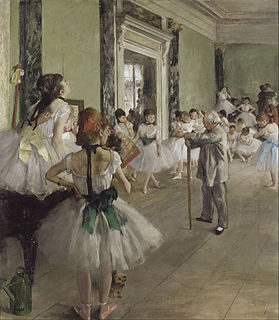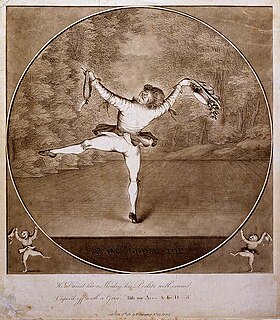
August Bournonville was a Danish ballet master and choreographer. He was the son of Antoine Bournonville, a dancer and choreographer trained under the French choreographer, Jean Georges Noverre, and the nephew of Julie Alix de la Fay, née Bournonville, of the Royal Swedish Ballet.

The Royal Danish Ballet is an internationally renowned classical ballet company, based at the Royal Danish Theatre in Kongens Nytorv, Copenhagen, Denmark. It is one of the oldest ballet companies in the world and originates from 1748, when the Royal Danish Theatre was founded. It was finally organized in 1771 in response to the great popularity of French and Italian styles of dance. The company was founded with the opening of the Royal Danish Theatre, which has served as its home since that time.The Royal Danish Ballet school was founded in 1771 under the French ballet teacher Pierre Laurent (1730-1807), Then Vincenzo Galeotti developed it and August Bournonville founded his methodology for the school.

Erik Belton Evers Bruhn was a Danish danseur, choreographer, artistic director, actor, and author.
La Sylphide is a romantic ballet in two acts. There were two versions of the ballet; the original choreographed by Filippo Taglioni in 1832, and a second version choreographed by August Bournonville in 1836. Bournonville's is the only version known to have survived and is one of the world's oldest surviving ballets.
Margot Ella Florentz Lander, a prima ballerina with the Royal Danish Ballet, was the most important Danish ballerina of the first half of the twentieth century.

Les Ballets Trockadero de Monte Carlo is an all-male drag ballet troupe that parodies the conventions of romantic and classical ballet. In 2008, they performed at the Royal Variety Performance in front of Prince Charles. The company's current artistic director is Tory Dobrin.

The Flower Festival in Genzano is a one-act ballet by Danish choreographer and ballet master August Bournonville (1805–1879). Bournonville created the work for Denmark's Royal Ballet in 1858 specifically on December 19, 1858, at the Royal Danish Theatre, on the basis of general enthusiasm among the Danes for Italy. The libretto is adapted from a tale found in Impressions de voyage by Alexandre Dumas and tells the story of a pair of young lovers, Rosa and Paolo, who alludes to the festival that is still celebrated in Genzano, Italy, during the month of June. The music is by Edvard Helsted and Holger Simon Paulli. Bournonville was a dancer, choreographer, ballet teacher and director; son of the dancer and French ballet master Antoine Bournonville, who had been a disciple of the great Noverre. Auguste was born in Copenhagen in 1805, studied with his father and completed his training in France - with the last virtuoso of the French classical style, Vestris - before becoming a star of the Paris opera. But Bournonville's personal contribution to the development of romantic ballet in the course of his long reign as head of the Royal Danish Ballet far outweighed French influence. Bournonville created a repertoire of more than 50 ballets, a school and its own style. The characteristic of his repertoires is that he was able to maintain real characters, that the dancers are as they are, and looking for exotic places for his works.

The Kermesse in Bruges, or The Three Gifts is a burlesque ballet in three acts created by the Danish ballet master and choreographer August Bournonville to music by Holger Simon Paulli, first performed by the Royal Danish Ballet on 4 April 1851. The Danish title is Kermessen i Brügge eller De tre Gaver. The ballet tells the story of three brothers who receive magic gifts from an alchemist.
Nikolaj Hübbe is artistic director of the Royal Danish Ballet.
Thomas Lund is the head master of The Royal Danish School of Ballet in Copenhagen. Lund admitted to The Royal Danish School of Ballet in 1986 aged 11. He became apprentice in 1991, member of the corps de ballet of The Royal Danish Ballet in 1993, soloist in 1996 and was appointed principal dancer in 2000. In September 2012 Lund retired as a Principal Dancer to become the head master of The Royal Danish School of Ballet.
Gudrun Bojesen is a Danish ballet dancer. Since 2001, she has been a principal dancer with the Royal Danish Ballet.

Paul James Rooney is an English choreographer, dancer and rehearsal director. He danced with various companies and choreographers around the world, including names such as; Matthew Bourne, Tim Rushton, Michael Flatley, Will Tuckett, Danish Dance Theatre & choreographed many productions for Tivoli (Copenhagen)
Hans Brenaa was a Danish dancer, teacher, and ballet director. He studied at the Royal Danish Ballet School from 1918 and joined the company in 1928; promoted to principal in 1945. He created roles in George Balanchine Legend of Joseph (1931) and in numerous ballets by Lander, including Études (1948). He produced Aurora's Wedding for the Royal Danish Ballet in 1950. After retiring from the stage in 1955 he became a producer, staging the Bournonville repertoire in Denmark and elsewhere. He also taught at the Royal Danish Ballet School in Copenhagen from 1942 and was a tireless teacher of the Bournonville style throughout Europe and America. Among the Bournonville productions he staged for the Royal Danish Ballet are The Kermesse in Bruges, La Sylphide (1967), Konservatoriet (1968), The King's Volunteers on Amager (1970), Far from Denmark (1973), and La Ventana (1979). Brenaa made the more straightforward and ingenuous ballets dance across the stage with an infectious vitality. During the periods in which Hans Brenaa was absent from the theatre, Kirsten Ralov was the custodian of the Bournonville tradition. In 1979 she committed the Bournonville Schools to paper.
Cyril Atanassoff is a Bulgarian dancer originally from France.
Silja Maria Wendrup Schandorff is a Danish ballerina who performed with the Royal Danish Ballet from 1985 to 2009. She has since served the Royal Theatre as ballet instructor and deputy ballet master.
Anna Regina Tychsen (1853–1896) was a German-born Danish ballet dancer. Although she was not very attractive and lacked charm, she perfected her technique with the result that she became a soloist as early as 1872. She is remembered in particular for her roles in August Bournonville's ballets, performing the title role in La Sylphide, Eliza and Victorine in Le Conservatoire and Céleste in Torreadoren.















